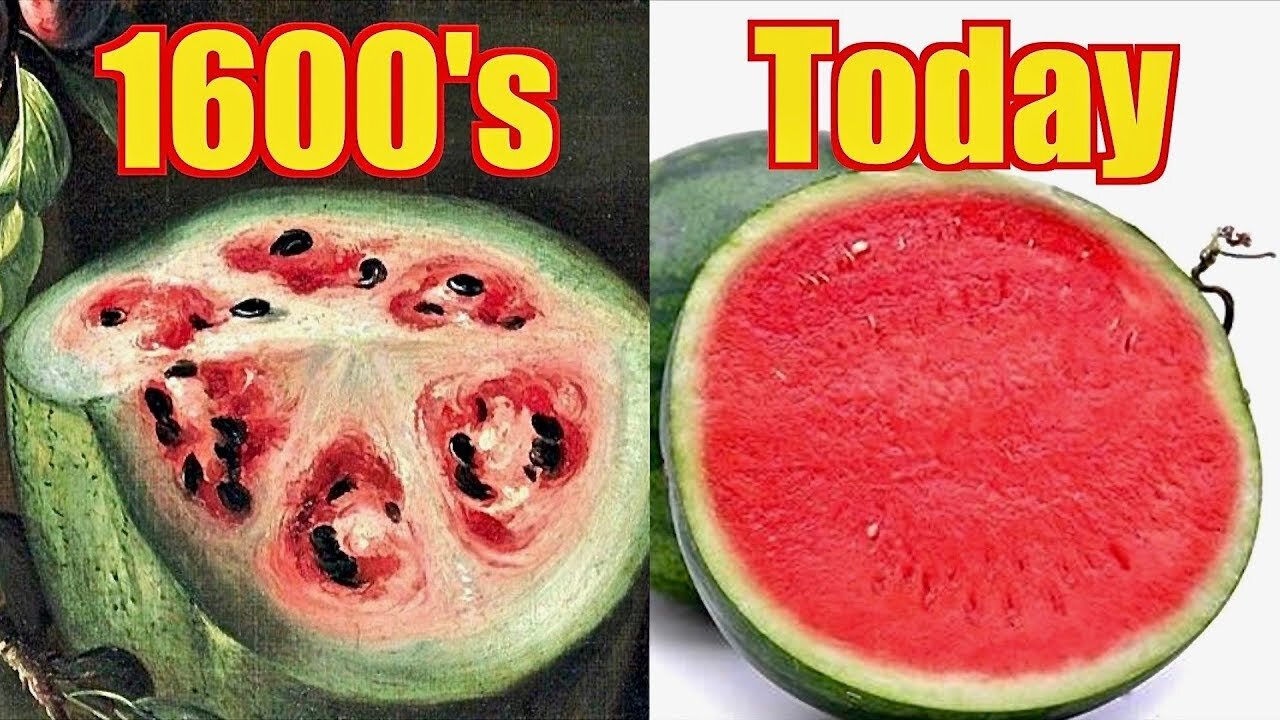Premium Only Content

How Fruits & Vegetables Evolved Over Centuries of Agriculture
Agribusiness is a genuinely late innovation, just around 10,000 years of age. Since horticulture started, many generations of agriculturists have falsely reproduced harvests to choose for more attractive characteristics, similar to size and taste. Obviously, your most loved foods grown from the ground have changed radically throughout the hundreds of years. The world is in a constant state of flux. Things are changing every second of every day, sometimes slowly, sometimes quickly, and this is a natural part of life. So it should come as no surprise that much of the food we eat today has changed as well, and bears little resemblance to its distant forebears. There are many reasons for this, including evolution and plant/animal interactions within ecosystems, changes in farming technology and methods — GMOs are one unfortunate example of this — and plant hybridization, which is in itself an agricultural technology.
Once we began growing these particular fruits and vegetables en masse to meet the demands of consumers, they started to change. Take a look at what fruits and vegetables used to look like, before we domesticated them.
Watermelon
The image above is a watermelon painted by Giovanni Stanchi in the 17th century. James Nienhuis, a horticulture professor at the University of Wisconsin, told Vox, “It’s fun to go to art museums and see the still-life pictures, and see what our vegetables looked like 500 years ago.” He uses the Stanchi painting to teach his classes about the history of crop breeding. Some claim that the watermelon is just unripe or under-watered, but the presence of black seeds in the fruit indicates that it was ripe.
Today we have bred watermelons to be much smaller, with a white lining and bright red flesh, which is actually the watermelon’s placenta. Before domestication, the placenta lacked the high amounts of lycopene necessary to give it that red colour. We have also created seedless varieties of watermelon in recent years, which may well become the standard.
Banana
The first bananas are thought to have been cultivated about 10,000 years ago in what is now known as Papua New Guinea. Portuguese colonists in the 15th and 16th centuries established banana plantations in the Atlantic Islands, Brazil, and Western Africa. North Americans soon began consuming bananas on a small scale; it was only until the 1880s that it became more widespread.
Today our hybrid bananas come from two wild varieties, Musa acuminata and Musa balbisiana, which had large, hard seeds, like the ones in this photo. The modern banana has much smaller seeds, contains more nutrients, and, it has been conjectured, tastes much better.
Eggplant
The eggplant has made appearances in Chinese literature, specifically in the Tong Yue, dated to 59 BC. Domestication is believed to have started in India, China, Thailand, Burma, or someplace else in southeast Asia. It is believed that the first use of eggplant was most likely medicinal, because its flesh has a bitter aftertaste if left untreated.Domesticated eggplants had round and green fruits, while today’s cultivars feature an incredible range of colors. Wild eggplant is prickly, and today the domesticated versions have few or no prickles.
Carrot
It is believed that the earliest carrot reference dates back to the 10th century in Persia and Asia Minor, but these vegetables would have borne little resemblance to the carrots we are so familiar with today. Carrots were originally purple or white and quite thin. A mutation is thought to have occurred at some point in their development which removed the purple pigmentation, creating a new race of yellow carrot, from which orange carrots later evolved. Farmers then turned the thin, white roots with a strong flavor and biennial flower into the large and tasty orange roots we enjoy today.
Corn
The corn we know and love today looked nothing like the barely edible teosinte plant it was bred from. Corn was first domesticated in 7,000 BC and was dry like a raw potato. Today corn is the number 1 grown crop in the U.S and nearly all of it (88 percent) is genetically modified. It is now 1,000 times larger than it was 9,000 years ago and 6.6% of it is made up of sugar compared to 1.9% in natural corn.
Peaches
The ancient Chinese developed a small, wild fruit that tasted like lentils in 4,000 BC. Farmers selected the tastiest fruits for re-planting, and because they tended to the trees for thousands of years, the fruits became bigger and juicer with each subsequent generation. Now, after 6,000 years, our peaches are 16 times larger, 27% juicier, and 4% sweeter than their distant ancestors.
#Evolution #History #Interesting
Music: Star of the Conqueror by Dhruva Aliman
Amazon- https://amzn.to/2Mgr7pg
https://music.apple.com/us/artist/dhruva-aliman/363563637
https://dhruvaaliman.bandcamp.com/album/the-wolf-and-the-river
http://www.dhruvaaliman.com/
Spotify - https://open.spotify.com/artist/5XiFCr9iBKE6Cupltgnlet
-
 2:53
2:53
Seeker Land
1 month agoHow 14 Wolves Changed The Path Of Rivers in Yellowstone Park - Amazing True Story
48 -
 LIVE
LIVE
Badlands Media
9 hours agoBadlands Daily: August 25, 2025
2,201 watching -
 UPCOMING
UPCOMING
Major League Fishing
3 days agoLIVE! - Fishing Clash Team Series: Challenge Cup - Day 2
500 -
 35:18
35:18
The Quiet Part
2 hours agoMAID Is Coming for the Mentally Ill — But This Could Change Everything
67 -
 LIVE
LIVE
LFA TV
14 hours agoLFA TV ALL DAY STREAM - MONDAY 8/25/25
4,942 watching -
 LIVE
LIVE
Surviving The Survivor: #BestGuests in True Crime
1 hour agoLIVE Court: Wendi Adelson Testifies Against Mom, Donna Adelson, in Dan Markel's Murder Trial
256 watching -
 LIVE
LIVE
JuicyJohns
1 hour ago $0.05 earned🟢#1 REBIRTH PLAYER 10.2+ KD🟢
100 watching -
 1:14:57
1:14:57
JULIE GREEN MINISTRIES
3 hours agoRUSSIA IS ABOUT TO RELEASE SOMETHING THAT WILL CRUSH THE ESTABLISHMENT
65.5K169 -
 LIVE
LIVE
GritsGG
1 hour agoWin Streaking! Coloring Hair at End of Stream! Most Wins 3435+ 🧠
38 watching -
 1:33:58
1:33:58
Welcome to the Rebellion Podcast
20 hours ago $0.03 earnedMonday Funday - WTTR Podcast Live 8/25
12.2K1